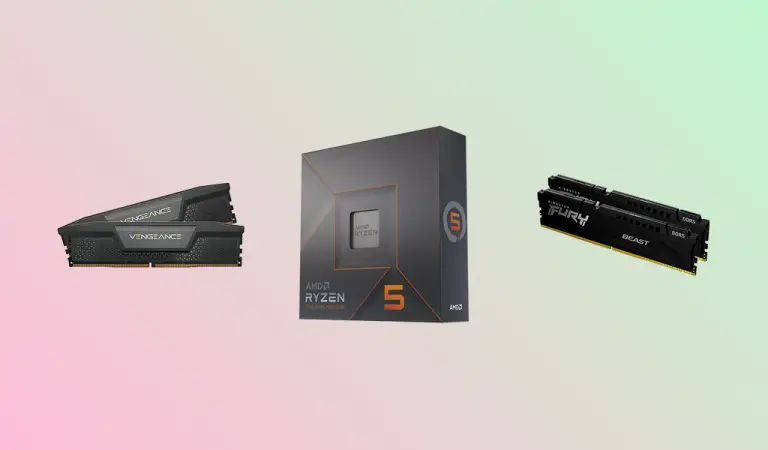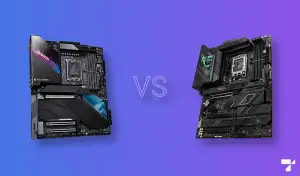Zen 4 architecture brings with it DDR5 as a system requirement for its memory. So when building a PC with the Ryzen 5 7600X, you should aim for more cost effective DDR5 RAM options that also perform well. The best RAM for the Ryzen 5 7600X no longer calls for simpler frequency gains and strictly tighter CL timings. The focus shifts slightly more towards the management of these memory settings along with your budget.
Then you have other unique design points, such as the memory controller and voltage regulator being installed directly on the memory stick itself. These then lead to other priorities, such as better cooling efficiency, or making sure that stability is maintained regardless of any (reasonable) tuning.
In particular, Ryzen 7600X’s Infinity Fabric is no longer set manually. Rather, it is recommended on auto, with the DDR5 RAM frequency set to 5,200Mhz to take advantage of the minimum 1,733Mhz FCLK. Users are then incentivized to climb up further to 6,000Mhz which is considered the sweet spot of stability and performance.
Adding further to this, CAS latency is no longer an issue with Ryzen 7000. Tightening the timings are, of course, still beneficial. But will no longer be a significant detriment for the higher values that they seem to indicate. Plus you can utilize AMD EXPO‘s extended overclocking profiles for improved RAM performance when paired with the 7600X. It is also important to note that the RAM recommended below work well with both the Ryzen 5 7600X and the non-X Ryzen 5 7600.
Best RAM for Ryzen 5 7600X
1. Corsair Vengeance
Verdict
Corsair Vengeances, is one of the best go-to memory kits for a standard Ryzen 5 7600X system with basic profiles out of the box, while can give a bit of headroom for personal tunings.
Specifications
Memory Type: DDR5 | Capacity: 32GB (2x16GB) | Speed: 5,600MHz | CAS Latency: 36 | Timings: 36-36-36-76 | Voltage: 1.25V | Height: 35mm/1.38″ | Warranty: LifetimeBenefits
- Good enough tuning headroom (for its class)
- Low-profile heat spreader
- Stability ensured for most reasonable settings
Drawbacks
- Thin heat spreader?
Buying Options
These Corsair Vengeance memory modules provide good performance out of the box and stable profiles without sacrificing too much in terms of cost compared to other more premium DDR5 options for AM5 CPUs. In fact, even with the already generous 5,600Mhz CL36 default setting, we find that there is still a tiny bit of room to set your personal tunings, without worrying about crashes or constant restarts.
Being a Corsair memory module, the heat spreader sports a very simple, yet still adequately striking design that prevents it from being considered too barebones. Though, it does look quite worryingly thin when viewed sideways.
To conclude, the Corsair Vengeance is a good and reliable DDR5 RAM kit for the 7600X. Your priority here is reducing the cost of entry for DDR5 without sacrificing too much, not even in the aesthetics department with its updated visuals. Default OC profiles are very welcome, plus the tiny tweaking headroom. But for those who really want to stretch their legs in tuning DDR5, you might find these modules just a little bit disappointing.
2. Kingston Technology Fury Beast
Verdict
The Kingston Technology Fury Beast tempers your budget expectations for barebones and minimum required Infinity Fabric spec. But it is still reliable enough for the requirements of an AM5 platform.
Specifications
Memory Type: DDR5 | Capacity: 32GB (2x16GB) | Speed: 5,200MHz | CAS Latency: 40 | Timings: 40-40-40-80 | Voltage: 1.25V | Height: 35mm/1.37″ | Warranty: LifetimeBenefits
- Has additional overclocking headroom
- Low-profile heat spreader
- Very cheap
Drawbacks
- Very barebones design
Buying Options
Kingston’s Fury Beast memory modules pairs very well with the more budget-oriented Ryzen 5 7600X, a CPU with its cheaper cost and simpler design. 5,200Mhz is on the lower end. But at least it still gives us the default entryway to optimal Ryzen 7000 memory frequencies without the need for manual overclocking.
For its OC headroom, its maximum stable +200Mhz isn’t the best in the world, though it offers a tiny bit of improvement where we should never really have expected any for its price and tier. Tuning timings, however, is a bit tricky. You’ll have to check step by step since there seem to be more binned variations for this particular class of product. Try to go two points each step, then see how far you can go.
Barebones as it may look to be, Fury Beast modules don’t really look half as bad in reality. Black sticks tend to blend perfectly into most generic PC aesthetics. No RGB on this one, though.
Size-wise, it is a very low-profile module. Its sleekness in height makes it perfect for any smaller form factor system, or any of these crazy custom builds that you see on sites like Aliexpress. You can use just about any type of downdraft cooler as well, further reinforcing its versatility for any tighter physical configuration that you may use it for.
All in all, the Fury Beast memory kit is a solid choice for the Ryzen 5 7600X simply due to its cost balance. You definitely aren’t splurging for high-end components with such a system anyway.
3. Corsair Dominator Platinum
Verdict
Corsair’s Dominator Platinum is an overkill memory for the Ryzen 5 7600X. But if you can spend a bit more extra for a pair, then it could offer great reliability with its signature design.
Specifications
Memory Type: DDR5 | Capacity: 32GB (2x16GB) | Speed: 5,200MHz | CAS Latency: 38 | Timings: 38-38-38-84 | Voltage: 1.25V | Height: 56mm/2.2″ | Warranty: LifetimeBenefits
- Top-notch build quality
- Stylish and eye-catching
- Great out-of-the-box performance
Drawbacks
- OC headroom is kind of too little for its class
- 56mm heat spreader height
Buying Options
Corsair’s Dominator Platinum is yet another premium set of modules that we normally don’t recommend for lower-tier builds. But if you’re looking for a no-muss, no-fuss installation experience paired with a very attractive-looking set of modules, and funds can be extended a bit, then this is not a bad choice.
It starts with a profile of 5,200Mhz CL38, which is perfect for achieving the intended optimized minimum for Zen 4 CPUs. By design, we are allowed a bit of overclocking headroom to extend this to about 5,400Mhz. Unfortunately, this is the maximum that we can get it to run at a stable rate. It should make for a smoother access experience when playing around with your apps during normal use.
The other half of its value is its looks. The Dominator Platinum is built with a very sleek black design that has a good heft to it, making it feel very premium. At 56mm tall, though, it can be a bit too high, so double-check your air cooler’s height allowance, just in case.
RGB is another perk that accounts for its attractive appeal when installed on a motherboard. The square dots around is pretty unusual since most memory kits opt for an entire light bar or set of lines running through the entire top of the memory module. Lighting is not as ambient as with other modules, but it doesn’t look too bright either. Also, there’s the iCue software for both memory monitoring and RGB configurations to keep that part of its spec balanced.
4. Crucial DDR5 Desktop Memory
Verdict
Crucial’s super basic desktop memory modules are the cheapest, and ironically the absolute best experimental ground for your Ryzen 5 7600X system.
Specifications
Memory Type: DDR5 | Capacity: 16GB (2x8GB) | Speed: 4,800MHz | CAS Latency: 40 | Timings: 40-39-39-77 | Voltage: 1.1V | Height: 31mm/1.23″ | Warranty: LifetimeBenefits
- Black PCB
- Superb overclocking freedom
- Cheapest DDR5 out there
Drawbacks
- No heat spreader
Buying Options
Crucial’s absolutely basic design and 4,800Mhz doesn’t seem to cut into what we need for a Ryzen 7000 system. But manually overclocking these inferior-looking modules actually turns them into one of the absolute best DDR5 memory in terms of cost-to-performance.
First off, as you would expect, these memory modules have a very large overclocking headroom simply due to their lowest default setting. At least according to what we can push, 5,400Mhz is the reliable maximum, with a CL timing of 40. That already puts it a bit beyond the minimum Auto Infinity Fabric threshold. It is quite impressive, especially when we compare it to other DDR5 memory sticks that essentially offer the same setting with additional costs.
In exchange for its cheaper cost and wide tunability is its barebones design. Like, even more barebones than the Corsair Vengeance and Kingston Fury Beast. It’s basically just a PCB with a DDR5 connector for a DIMM slot. No heat spreader or anything of the sort. The modules, memory controller, and the entire circuitry are perfectly visible.
On the plus side, that means its height is technically the lowest possible ever. Not even our low-profile heat spreader contenders in this list would be able to compete in the spaces that these black sticks could easily squeeze into.
To summarize, the Crucial basic desktop memory module is the cheapest gateway to DDR5 for a Zen 4 system. You may have to sacrifice aesthetics with its non-existent design, but it has the performance level to match, or even best the competition where it matters the most. On the condition, that you are savvy enough to optimize its OC settings and timings in the BIOS, or wherever AMD’s software would allow you to.
5. XPG Lancer
Verdict
The XPG Lancer DDR5 memory kit’s best value comes from getting the highest sweet spot frequencies and lowers timings all the while having great aesthetics.
Specifications
Memory Type: DDR5 | Capacity: 32GB (2x16GB) | Speed: 6,000MHz | CAS Latency: 40 | Timings: 40-40-40-80 | Voltage: 1.25V | Height: 43mm/1.69″ | Warranty: LifetimeBenefits
- Considerable CL tuning allowance
- Stable performance under reasonable settings
- Unified RGB lightning
Drawbacks
- PMIC doesn’t have any thermal pads
Buying Options
Normally, the XPG Lancer wouldn’t really have any room for the likes of the middle-class Ryzen 5 7600X. But its maxed-out sweet spot, good room for customization, and actually kind of balanced cost make it worth the extended investment. As widely known, it can ramp up its 6,000Mhz frequency and CL40 timings very nicely for all the memory-intensive gains that you can expect.
Its black slate and brushed aluminum finish heat spreader design and unified RGB lighting aren’t really meant for lower-tier builds. But, they are still well appreciated. Oddly though, the PMIC on the memory stick does not seem to be directly connected to the heat spreader via thermal pads. This does not seem to be an issue though, since we’ve already confirmed its performance stability well before we even pried open the heat spreader.
In any case, the XPG Lancer demonstrates DDR5 in its finest form of balance (relatively speaking). Not only does it provide the theoretical sweet spot on the onset, but it also has a good-ish tuning headroom, combined with very good stability on every reasonable setting your make.
What To Look for When Buying Ram for the Ryzen 5 7600X
Capacity
Your minimum target should be 16GB (x2 8GB). There is ample argument to extend this to 32GB with certain applications. For one thing, this leaves a lot more room to simultaneously open apps that users want to switch around during the course of the day. Some games might also be specifically RAM-hungry, such as Cities Skylines. But we expect that the average Ryzen 5 7600X user won’t be the high-productivity crowd, nor would they be the hardcore enthusiast type. So 16GB would still be plenty for everything. Plus, if ever you hit your page file a bit too often, the AM5 platform supports blazingly fast PCIe 5.0 and PCIe 4.0 speeds. You’d hardly feel drive data fetch delays if ever.
Frequency
5200Mhz is the technical Infinity Fabric-synced minimum, and 6000Mhz is the most optimal. Ryzen 7000’s Infinity Fabric is set at 1,733Mhz by default, requiring an equivalent of at least 5200Mhz DDR5. It is worth remembering that Infinity Fabric for Ryzen 7000 needs to be set at Auto, as it will no longer function optimally when set to the traditional 1:1:1. 6000Mhz is then considered the best sweet spot, but it is not strictly needed, so you can simply aim to push the clocks as high as you can between these two frequencies.
Latency
Don’t be too hard on DDR5 CAS latency. The Ryzen 5 7600X may be the most dependent on RAM configurations out of all Zen 4 processors. But if you get your DDR5 to a good optimized speed, then you only have to tune as far as your kit’s binning would go. For gaming, this becomes even less of a concern if gaming at resolutions higher than 1080p.
Dual-Rank versus Single-Rank
Dual-rank memory is faster than single-rank memory. Not exactly tangible, but still quantitatively measurable. This means that dual-rank quite outpaces single-rank due to modules being installed on both sides of the stick. On the flip side, single-rank is better at overclocking because you don’t have to account for the frequency stability of both sides. Dual-rank also has trouble achieving stability with four RAM sticks, as you would have to settle for lower clocks due to inherent synchronization issues. They’re best configured at two sticks with the recommended profile set by the manufacturer.
Dual-Channel versus Single-Channel
Dual-channel is better than single-channel. Dual-channel is a simple configuration that doubles the effective memory bandwidth for your CPU. It’s as easy as using two sticks at minimum, and four at maximum. When using two on a four DIMM-slot motherboard, be sure to install them in the correct dual-channel connection. The configuration is usually either installing them into same-colored DIMM slots, or alternating ones. You can also check your motherboard’s white labels or instruction manual for this information as well
Pricing
The target CPU should always take the bulk of the investment before the RAM. Ryzen 5 7600X isn’t particularly costly compared to its higher-tier Zen 4 counterparts. So stick to mid-tier and entry-level priced DDR5 RAM, unless you want to get a bit flashier.
Final Thoughts
The Ryzen 5 7600X is the baseline Zen 4 CPU that is available for consumers. It doesn’t bring a lot of cores or cache, making it slightly even more memory dependent that the Ryzen 7 7700X. But it still has the same architecture. So additional memory tunings beyond default optimized ones would not affect it too much regardless. You’re better off going for a stable setting within the recommended frequency and latency range, than trying to splurge on some maxed-out RAM with settings that you’ll never even practically notice. And the same applies to the non-X Ryzen 5 7600.
In fact, we dare say that you should go as barebones as possible for the Ryzen 5 7600X. If memory kit quality is guaranteed, you are at least given the tuning headroom that you need to personalize your setup within the needed optimization range.



